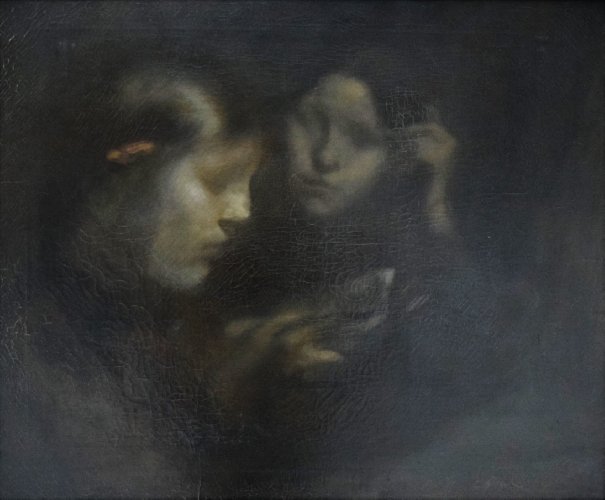Description:
Eugène Carrière was a French painter and graphic artist. He studied at the École des Beaux-Arts and co-founded the Société Nationale des Beaux-Arts with Puvis de Chavannes. He was inspired by the works of Rembrandt and Turner, whose influence can be seen in his art. His mature painting style was characterized by monochromatism, mystery and understatement. He often addressed the theme of motherhood by painting his wife and seven children.
Description of the painting:
The painting depicts two bright female faces in a dark and undefined space. One of them is solemnly holding a book in front of her. Although her lips are silent, the captivated look of the other girl suggests that the scene is of a loud reading. The pale, yellow-green light falling on the portrayed figures resembles a moonlit glimmer. This creates a somewhat unsettling atmosphere of mystery. Looking more closely at the painting, one can attempt to penetrate the darkness to find more details, yet it proves to be impossible.
The girls in the painting are Nelly (with the book) and Lucy, the painter’s daughters. His children were often models in his works. He had seven of them with his wife Sophie Desmouceaux, whom he also often portrayed. He was even given the nickname “the painter of motherhood”, which simplifies his artistic achievement, as in Carrière’s work, it was not only what he portrayed, but also how he did it.
The painter had a close friendship with the sculptor Auguste Rodin. Their artistic works have interesting correlations, which the art critic Camille Mauclair expressed in the sentence: “Rodin paints in marble, and Carrière sculpts in shadow”. Rodin’s figures come out of rough, rough stone, and Carrière’s models from an undefined, dark background. Both artists used fragmentary representation of reality and its distortion, in favor of the atmosphere and symbolic expression of the work. The term “sculptor of paintings” is justified in the sense that there is a lack of painterly freedom, brush strokes, coloristic searches or colorful perspectives in his paintings. In the painting “Reading”, like from a stone or clay block, the artist extracts monochromatic reliefs of faces and hands, revealing only some parts of the painting through pale light, leaving the rest undiscovered and unprocessed. He does not mark clear boundaries, edges and lines that disperse in the sfumato technique. On the one hand, by portraying his daughters, he gives them access, and on the other, he protects them by leaving them in an inaccessible, unspoken, mysterious reality for the viewer.


